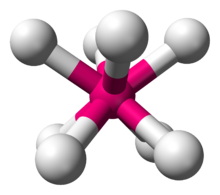Square antiprismatic molecular geometry
| Square antiprismatic molecular geometry | |
|---|---|
 | |
| Examples | XeF2− 8, ReF− 8 |
| Point group | D4d |
| Coordination number | 8 |
| μ (Polarity) | 0 |
In chemistry, the square antiprismatic molecular geometry describes the shape of compounds where eight atoms, groups of atoms, or ligands are arranged around a central atom, defining the vertices of a square antiprism.[1] This shape has D4d symmetry and is one of the three common shapes for octacoordinate transition metal complexes, along with the dodecahedron and the bicapped trigonal prism.[2][3]
Like with other high coordination numbers, eight-coordinate compounds are often distorted from idealized geometries, as illustrated by the structure of Na3TaF8. In this case, with the small Na+ ions, lattice forces are strong. With the diatomic cation NO+, the lattice forces are weaker, such as in (NO)2XeF8, which crystallizes with a more idealized square antiprismatic geometry.
-
The distorted square antiprismatic [TaF8]3− anion in the Na3TaF8 lattice.[4]
-
The square antiprismatic [XeF8]2− anion in the lattice of nitrosonium octafluoroxenate(VI), (NO)2XeF8.[5]
-
Structure of the Bi82+ cluster in the [Bi8](GaCl4)2.
Examples
- XeF2−
8 - IF−
8 - ReF−
8
Square prismatic geometry and cubic geometry
Square prismatic geometry (D4h) is much less common compared to the square antiprism. An example of a molecular species with square prismatic geometry (a slightly flattened cube) is octafluoroprotactinate(V), [PaF8]3–, as found in its sodium salt, Na3PaF8.[6] While local cubic 8-coordination is common in ionic lattices (e.g., Ca2+ in CaF2), and some 8-coordinate actinide complexes are approximately cubic, there are no reported examples of rigorously cubic 8-coordinate molecular species. A number of other rare geometries for 8-coordination are also known.[2]
References
- ISBN 9780470166253.
- ^ .
- ISBN 0-19-855370-6
- PMID 20814090.
- S2CID 22384146.
- ISSN 0022-4944.

![The distorted square antiprismatic [TaF8]3− anion in the Na3TaF8 lattice.[4]](http://upload.wikimedia.org/wikipedia/commons/thumb/0/02/TaF83-Core.png/130px-TaF83-Core.png)
![The square antiprismatic [XeF8]2− anion in the lattice of nitrosonium octafluoroxenate(VI), (NO)2XeF8.[5]](http://upload.wikimedia.org/wikipedia/commons/thumb/3/30/Octafluoroxenate%28VI%29-3D-balls-A.png/164px-Octafluoroxenate%28VI%29-3D-balls-A.png)
2.](http://upload.wikimedia.org/wikipedia/commons/thumb/6/65/EntryWithCollCode414090.png/135px-EntryWithCollCode414090.png)